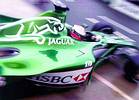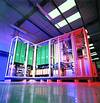

In Formula 1, the difference between winning and losing is often measured in hundredths or thousandths of a second. However, even a team that has such an edge cannot enjoy success if its cars are not running when the chequered flag falls. Reliability also wins races, a fact recognised by the enormous sums that F1 teams spend to prove components under race conditions in the test laboratory. Jaguar Racing is at the forefront in this respect. The team has recently invested in a large (160 kW) inverter-based gearbox test rig which has been designed, constructed, programmed and installed by drives systems specialist Control Techniques.
Built at Control Techniques' Luton Drive Centre, the gearbox test rig, and its associated motors, (also supplied by Control Techniques) are now part of a suite of advanced testing facilities at Jaguar Racing's prestigious new F1 headquarters in Milton Keynes. The function of the rig is to simulate the on-track conditions gearboxes routinely encounter during F1 races. These can include load on one wheel only, (ie because the other has lifted), or simulating the over-run condition when the wheels drive the engine (which entails reversing the torque direction).
The test rig consists of three 160 kW motors, each driven by size 5 Unidrives, and a 5,5 kW motor controlled by a size 2 Unidrive. The first of the l60 kW motors runs in speed control mode and mimics the input from the engine. Driving through a step up gearbox at 4300 rpm, it gives a maximum speed into the Jaguar Racing gearbox of 18 000 rpm. The two remaining 160 kW motors are torque controlled. They are coupled to the output shafts of the Jaguar Racing gearbox and simulate the output loads. The final smaller 5,5 kW motor is referenced from the input drive and drives the gearbox oil pumps.
The control for the drive system is provided via Control Techniques' high-speed fieldbus system, CTNet, in conjunction with the company's SYPT, Windows based, graphical programming software. This combination provides the master speed reference to the input drive, ensures independent torque control or load sharing for the output drives and furnishes the test engineers with a graphical display to aid dynamic diagnostics. The SYPT software also produces torque and speed displays for the console in the test rig control room.

The rig - a crucial tool in race preparation
The test rig is in regular use, due in no small part to the requirement to have three gearboxes (two spares) available for any race. The gearboxes themselves fall into two categories: brand new units and used units that have been refurbished or rebuilt. Each newly built gearbox is subjected to a test of at least 45 minutes in both forward and reverse torque directions. For used gearboxes the total test time is usually less, typically 1 h. The tests on both units start with a warm up period under no load conditions. This enables the test engineers to monitor the oil flow rates and check the lubrication pressure and temperature before moving into second phase where loading is increased progressively right up the rev scale to a maximum (usually) of 16 000 rpm. During this run-up the comprehensive facilities provided by the test rig enable the test engineers to tune sensors in the gearbox, and to calibrate clutch and gear positions using paddles on an F1 steering wheel in the rig control room.
According to Rob Dorney, Transmission Designer at Jaguar Racing, "We have used the rig extensively to run in gearboxes prior to race events and for research and development purposes. It has proved invaluable for function testing the gearboxes, calibration and fault finding. There have been several instances where the rig has flagged up transmission problems before the gearbox is fitted to the car, preventing car breakdowns and therefore saving valuable track time."
Regenerative drive system minimises energy use
The length of the tests with a conventionally configured 160 kW drive system would normally mean quite a hefty electricity bill for Jaguar Racing. However the actual energy used in the testing procedure is insignificant due to the regenerative design of Control Techniques' drive system. When the test rig is in normal running condition, the power being used from the mains supply is negligible as a result of the power on the DC bus recirculating. This is achieved by the output drives putting power back into the common DC bus used by the input drive. The regenerative system capacity is considerably higher than what is needed for 'normal' running - the only time that almost full capacity is approached is when the system is stopping in an emergency.
"The installation of this rig is a further indication of how Control Techniques is able to take a problem, break it down and provide a system solution to solve it, commented Eddie Kirk, Control Techniques' UK Sales and Marketing Director. "The gearbox test rig is one of the first fruits of the technology partnership that Control Techniques has with Jaguar Racing. It is a terrific example of how the latest in technology in one industry sector can be transferred to provide benefits in another."
| Tel: | +27 11 462 1740 |
| Email: | [email protected] |
| www: | www.controltechniques.com |
| Articles: | More information and articles about Nidec Control Techniques |

© Technews Publishing (Pty) Ltd | All Rights Reserved